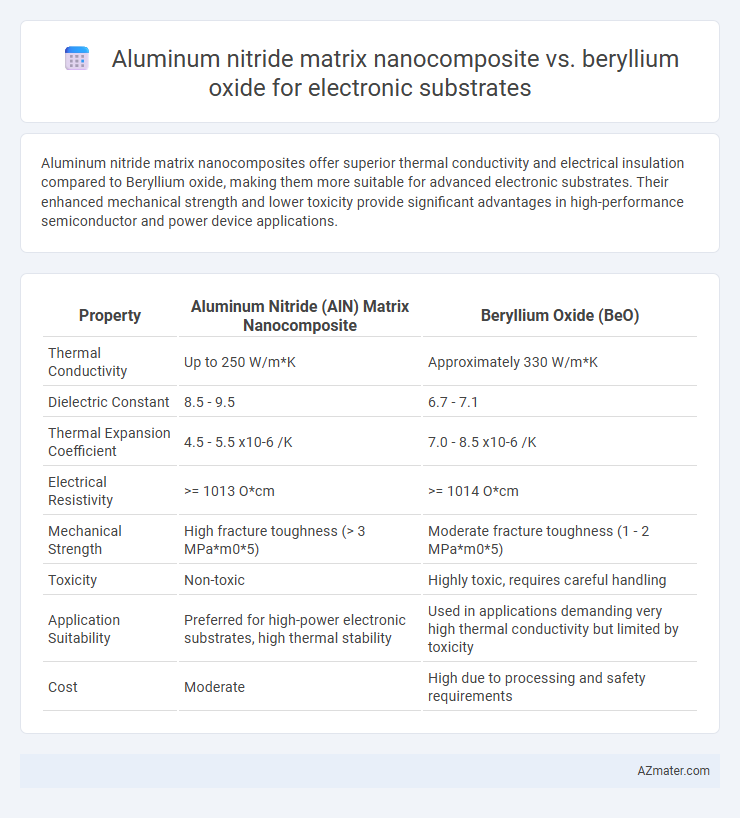Aluminum nitride matrix nanocomposites offer superior thermal conductivity and electrical insulation compared to Beryllium oxide, making them more suitable for advanced electronic substrates. Their enhanced mechanical strength and lower toxicity provide significant advantages in high-performance semiconductor and power device applications.
Table of Comparison
| Property | Aluminum Nitride (AlN) Matrix Nanocomposite | Beryllium Oxide (BeO) |
|---|---|---|
| Thermal Conductivity | Up to 250 W/m*K | Approximately 330 W/m*K |
| Dielectric Constant | 8.5 - 9.5 | 6.7 - 7.1 |
| Thermal Expansion Coefficient | 4.5 - 5.5 x10-6 /K | 7.0 - 8.5 x10-6 /K |
| Electrical Resistivity | >= 1013 O*cm | >= 1014 O*cm |
| Mechanical Strength | High fracture toughness (> 3 MPa*m0*5) | Moderate fracture toughness (1 - 2 MPa*m0*5) |
| Toxicity | Non-toxic | Highly toxic, requires careful handling |
| Application Suitability | Preferred for high-power electronic substrates, high thermal stability | Used in applications demanding very high thermal conductivity but limited by toxicity |
| Cost | Moderate | High due to processing and safety requirements |
Introduction to Electronic Substrate Materials
Aluminum nitride (AlN) matrix nanocomposites offer superior thermal conductivity around 180-200 W/mK combined with excellent electrical insulation, making them ideal for high-performance electronic substrates. Beryllium oxide (BeO) exhibits comparable thermal conductivity, approximately 230-280 W/mK, and outstanding electrical insulating properties but poses significant health hazards due to beryllium toxicity. Advances in AlN nanocomposites enhance mechanical strength and thermal expansion compatibility with semiconductor devices, positioning them as safer and more environmentally friendly alternatives in electronic substrate applications.
Overview of Aluminum Nitride Matrix Nanocomposites
Aluminum nitride matrix nanocomposites exhibit exceptional thermal conductivity up to 200 W/mK, making them ideal for high-performance electronic substrates requiring efficient heat dissipation. Their low dielectric constant (~8.5) and thermal expansion coefficient closely matching silicon (around 4.5 ppm/K) reduce thermal stress in microelectronic devices, enhancing reliability compared to beryllium oxide, which has higher toxicity concerns. Incorporation of nanoscale fillers improves mechanical strength and electrical insulation, positioning aluminum nitride nanocomposites as a safer, thermally efficient alternative to beryllium oxide in advanced electronic packaging applications.
Key Properties of Beryllium Oxide Substrates
Beryllium oxide (BeO) substrates exhibit exceptional thermal conductivity around 250-330 W/mK, surpassing aluminum nitride's typical 140-180 W/mK, enabling efficient heat dissipation in high-power electronic devices. BeO also offers excellent electrical insulation with a dielectric constant of approximately 6.7 and a low dielectric loss tangent, making it ideal for high-frequency applications. Its robust mechanical strength and chemical stability enhance device reliability in harsh environments compared to aluminum nitride matrix nanocomposites.
Thermal Conductivity Comparison
Aluminum nitride (AlN) matrix nanocomposites exhibit thermal conductivities typically ranging from 140 to 180 W/mK, making them highly effective for electronic substrates requiring efficient heat dissipation. Beryllium oxide (BeO) offers superior thermal conductivity, often exceeding 250 W/mK, but its toxicity and processing challenges limit widespread use. AlN nanocomposites balance high thermal conductivity with excellent electrical insulation and mechanical robustness, positioning them as safer and more versatile alternatives to BeO in advanced electronic packaging.
Electrical Insulation Performance
Aluminum nitride matrix nanocomposites exhibit superior electrical insulation performance with dielectric strength typically exceeding 15 kV/mm, making them highly suitable for high-voltage electronic substrates. Beryllium oxide offers excellent thermal conductivity but generally presents lower breakdown voltages around 10-12 kV/mm, which can limit insulation reliability under extreme electrical stress. The intrinsic high resistivity and stable dielectric properties of aluminum nitride-based composites ensure enhanced insulation stability and longevity in advanced electronic packaging applications.
Mechanical Strength and Durability
Aluminum nitride matrix nanocomposites exhibit superior mechanical strength and fracture toughness compared to beryllium oxide, making them more resistant to cracking under thermal and mechanical stress. The enhanced durability of aluminum nitride composites arises from their high thermal conductivity combined with a robust ceramic matrix that withstands oxidation and aging effects better than beryllium oxide. These properties result in longer service life and improved reliability as electronic substrates in high-power and high-frequency applications.
Thermal Expansion Coefficient Analysis
Aluminum nitride matrix nanocomposites exhibit a thermal expansion coefficient (TEC) closely matched to silicon, typically around 4.5 to 5.5 x 10^-6 /K, minimizing thermal stress in electronic substrates. Beryllium oxide features a slightly higher TEC, approximately 7 to 8 x 10^-6 /K, which can lead to greater mismatch-induced stress in integrated circuits. The superior thermal conductivity and lower TEC of aluminum nitride nanocomposites make them more favorable for high-performance electronic substrate applications requiring dimensional stability under temperature fluctuations.
Health and Environmental Considerations
Aluminum nitride matrix nanocomposites offer a safer alternative to Beryllium oxide in electronic substrates due to their non-toxic nature and lower environmental impact during manufacturing and disposal. Beryllium oxide, while possessing excellent thermal conductivity, poses significant health risks including chronic beryllium disease and requires strict handling protocols to prevent inhalation of dust particles. Furthermore, aluminum nitride's eco-friendly profile supports sustainable electronic device production by minimizing hazardous waste and exposure to toxic substances.
Cost-effectiveness and Manufacturing Scalability
Aluminum nitride matrix nanocomposites offer superior cost-effectiveness compared to Beryllium oxide due to lower raw material expenses and safer handling requirements, significantly reducing manufacturing overheads. Their compatibility with established semiconductor fabrication processes enhances scalability, enabling large-scale production without extensive equipment modifications. In contrast, Beryllium oxide's toxicity imposes stringent safety regulations and higher operational costs, limiting its economic viability and manufacturing throughput in electronic substrate applications.
Applications and Industry Trends
Aluminum nitride (AlN) matrix nanocomposites are increasingly favored in electronic substrates due to their superior thermal conductivity (up to 180 W/mK) combined with excellent electrical insulation, making them ideal for high-power electronic devices and LED packaging. Beryllium oxide (BeO) substrates offer comparable thermal performance but face declining use due to stringent health regulations and toxicity concerns, limiting their application in consumer electronics and aerospace industries. Emerging industry trends emphasize the shift towards AlN composites driven by their environmental safety, cost-effectiveness, and compatibility with advanced microelectronic manufacturing processes.

Infographic: Aluminum nitride matrix nanocomposite vs Beryllium oxide for Electronic substrate
 azmater.com
azmater.com